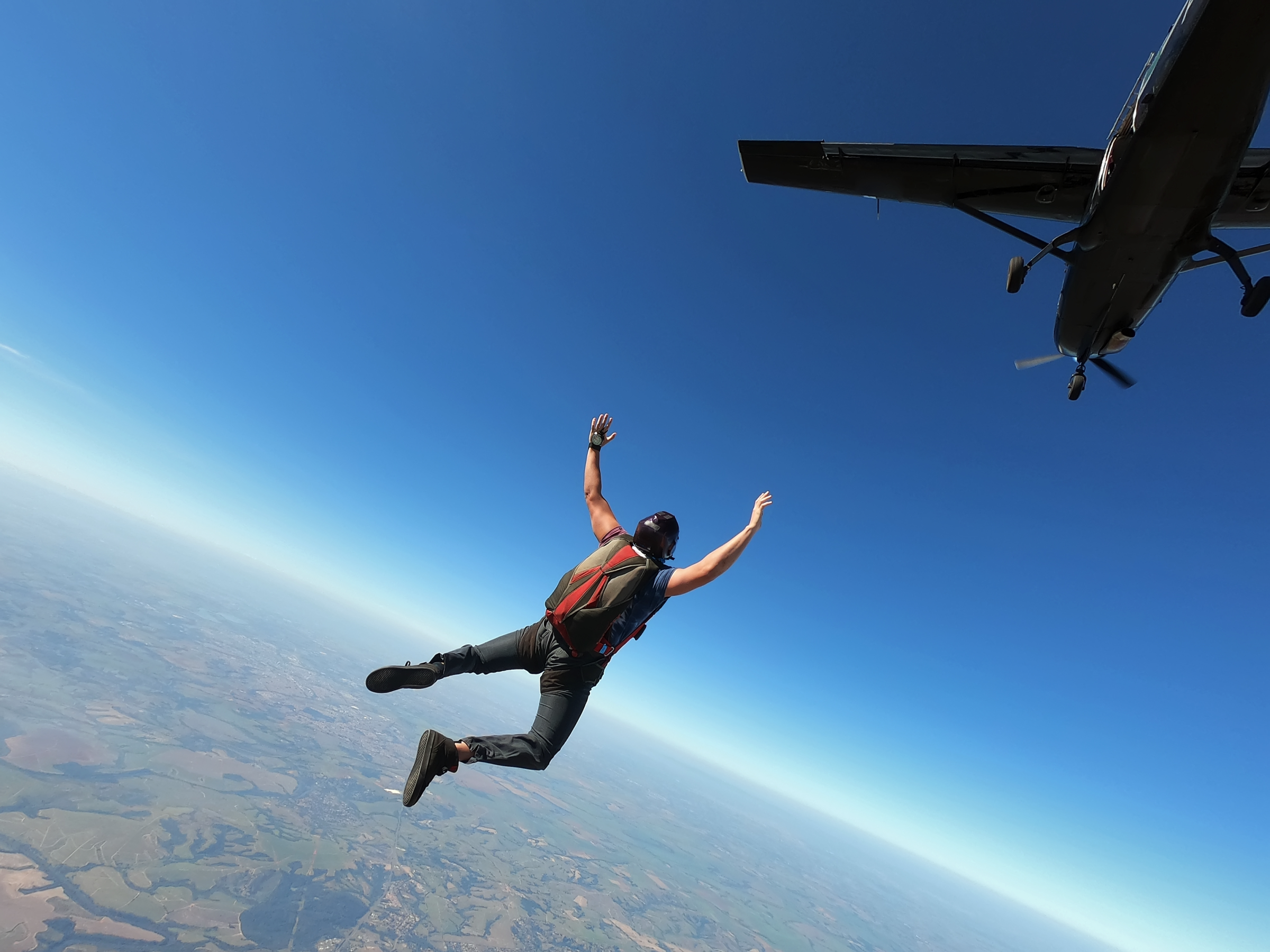Terminal Velocity.
Terminal velocity is the steady speed achieved by an object freely falling through a gas or liquid.

A skydiver in the belly-to-earth position reaches a terminal velocity of about 195 km/hr (121 mph). The world record terminal velocity was set by Felix Baumgartner, who jumped from 39,000 meters and reached a terminal velocity of 134 km/hr (834 mph).
From 14,500 feet in the air, the first step out of a plane traveling at 90 knots or 100 mph is intimidating. The ground below is a patchwork of colors with no distinguishing features. But I was undeterred. With a steely resolve, I dove into the blue, two jump masters close at hand.
The rest of my first freefall didn’t go as advertised. Back in those days, your first jump wasn’t tandem. Unlike video games where I could push pause or reset, I couldn’t crawl back into the aircraft. I was all the way out, hostage to Earth’s gravitational pull. I was fully committed. I was playing for keeps. I had opted to jump out of a perfectly good airplane in a sane, lucid moment. Fortunately, my jump was stable, accelerating toward my top-end horizontal speed of 120 MPH. 50% of terminal speed is reached in about 3 seconds. It takes 8 seconds to reach 90%. 15 seconds to reach 99%. I was moving fast.
If I remained horizontal and stable, my freefall would last almost 60 seconds. My dive conditions were spectacular. Serious blue skies gave me breathtaking views.

60 seconds into my descent, the issue of slowing down and landing became paramount in my mind. Terra firma is very unforgiving to the human anatomy when struck at 120 MPH. The aftermath is like a bug splat on a car windshield. Not good.
Deploying my parachute came next. This is the point where my story goes off the rails. I am not a stranger to pushing the edges of human performance. At this stage of my life, I was a dan ranked in three martial arts, a scuba diver, a soldier, and an instrument-rated pilot highly accustomed to risk calculation. I have dipped my toe into life-ending scenarios before and survived. Too many to count or remember. And I have also carried a casket containing the charred remains of a close friend killed by his poor judgment. The technical term is pilot error. Over the years, I have learned to compartmentalize debilitating fear and terror with the very best.
I survived my previous jousts with the grim reaper, not because of my innate brilliance or some genetic gift, but because I had amazing instructors preparing and training me. Exceptional men and women fully committed to keeping me alive, despite my best efforts otherwise. Every flight instructor, drill sergeant, Shihan, or divemaster pushed me. Hard. They simulated the worst conditions, applying real-life stressors repeatedly to improve me. Better than I wanted to be.
At 3,500 feet, I pulled the ripcord on my main. The vigorous pop of my silk savior yanked the straps inside my legs, alerting me to the problem. I wasn’t slowing down enough. My chute had not fully deployed. I looked up to confirm the situation. (See the picture below) My lines were tangled. Considered a low-speed malfunction, tangled lines result in a partially opened canopy which will not get the job done. I was slowing down, my half-opened chute providing substantial drag. But not enough for a survivable landing.

The clock was ticking in the back of my mind. My AAD, or automatic activation device, is a mechanical device that automatically opens the main or reserve parachute container if I don’t slow down. It would fire at 2,500 feet. In my current predicament, my reserve would deploy into my partially opened main, which might cause the reserve not to fully inflate, or I might end up having two chutes open. Neither scenario is optimal. I needed to clear the main open or cutaway to pull my reserve.
Plummeting to earth, I had only seconds to act. I did exactly as I had been trained to do in the situation. I stayed calm. I didn’t panic. My mind shifted gears into my high-performance zone and began " working on the problem.” I executed the recovery steps with a clear-eyed belief in my ability to follow instructions and cope with extreme situations. This wasn't my first near-death rodeo.
I pulled hard outwardly on the straps and rotated my body. Once. Twice. And finally, I jerked and spun hard enough to untangle the lines allowing the main to spring open with a hard jerk. I was juiced. My body raged with all the good hormones wired into our fight-or-flight instinct. The remainder of my ride to earth gave me a gorgeous life-affirming view of the world. I had survived another chance encounter with the edge of reason.

I could regale you with a dozen more stories of razor-edged episodes every performance junkie has at the ready. I don’t think about my survival in terms of death-defying. My edgy indulgences are the merger of exceptional preparation and training with the real risk of failure. And death. In the case of flying or sky diving, I calculate my endgame risk as smaller than being killed while driving my car on the freeway.
The highly skilled men and women who provided me with countless hours of harsh, unforgiving training in the sea, air, and conflict should take a bow at my advanced coping skills. I owe them my life a dozen times over. The moral of my story is simple. My instructors gave me an invaluable gift. They taught me to prepare, train, and be in the moment under high-intensity stressors, thereby coping with the worst and most difficult situations imaginable. I do not lose my shit under pressure. I perform as trained. The skills I depended on to save my life are transferrable to the daily grind.
What we really want out of life is not all the creature comforts, guaranteed outcomes, or never to be challenged. By now, you must realize life is an obstacle course, and material success and security can be fleeting. We don’t want participation trophies. What fun is that? What we really want out of life is to be able to cope with our challenges, missteps, and failures without losing our minds. We all want to be able to master life's many imperfections thrown at us.
My endless hours of stressful training taught me to trust my preparation and myself regardless of the odds or circumstances. To be present in the moment and persistent in the face of adversity. Certainty at my tender age, I am no longer indestructible. But life will not slow down to accommodate me. To adapt to the neverending cycle of change, I must remain relentless in my preparation and training and committed to being a little better every day.
My forthcoming book "Thinking4Tomorrow" (Late 2022), is my effort to shift your awareness in the quest for a more refined perspective. As a result of the timeless lessons in the book, I believe you can and will thrive at a new level. I hope you’re ready.
Until next time. Travel safe.

